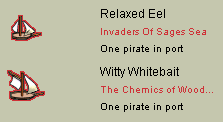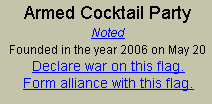War
- This article about the game mechanicism. For the crew on the Emerald Ocean, see War (crew). For the flag on the Meridian Ocean, see War (flag).
A flag's royalty may declare war on another flag as long as the current alliance web permits it. If the other flag reciprocates the declaration, then a state of open war exists between both of them. On Dark Seas oceans, the two factions are automatically in a permanent state of war.
Effects of war
Crews may not leave a flag while it is at war. They can, however, accept invitations into other flags, and can be expelled by the royalty. As with all crew expulsions, however, the issue can not be created by a royal of the crew in question.
Island embargo
When a flag declares war, its enemy's ships are embargoed from all islands owned by the flag. The embargoed ships may not port at those islands unless they pay a bribe, which goes into the palace coffers. (Note that the embargo is easily circumvented by allowing the ship to time out and autoport, if left at the league point for the embargoed island.)
Sinking PvP
When both flags have declared war, the most noticeable and important effect is sinking PvP. In a PvP sea battle between two ships at war, the rules are different than regular PvP. It is immediately obvious for all aboard a ship during a sinking PvP that it is not a regular sea battle. There is a warning whistle, a red warning message, and the sea battle interface also appears with skulls along the side. The enemy ship will also be outlined in red both on the board and in the corner of the screen, if the battle navigator is not in another puzzle.
If one ship maximizes the other's damage, then the damaged ship sinks and a ship in a bottle appears in the deed owner's inventory. However, unlike in regular sea battle, the damage meter on the enemy ship must be filled up completely (not to the maximum level of damage for a swordfight). Also unlike regular sea battle, repairs from Carpentry or Patching are taken into account- the actual damage bar on the enemy ship must be filled. If the ships grapple, the winner of the swordfight takes the entire contents of the loser's hold except for five units of rum.
Even at war, might rings still apply. Attacking a substantially weaker ship can result in getting the black ship. A clever opponent will wait for the attacker to finish being crushed by the black ship and then move in for the kill. During war, some players have attempted to use lower-ranked alts to circumvent might rings, and thus sink their enemy in an unfair fight. However, this is an example of alt abuse and is generally disallowed.
When two flags are at war with each other, their enemy's ships will have a red outline at sea and in port. This occurs after war declarations; the flag that declared war will see the enemy with red outlines, but the enemy will not see the flag that declared upon them as red. The reason for this is that a flag may reciprocate a war declaration at any time, so the declaring flag is informed of which ships may be able to start a sinking battle with them.
Issuing a war declaration
Flags cannot declare war against a flag that is allied to an ally of an ally (up to 3 levels out). To declare war, a royal must click Declare war on this flag on the opposing flag's information page. This will post an issue that other royals may vote on. Although /declarewar is popularly used on the forums, it is not a real command.
Cessation of war
A state of war lasts indefinitely. It can end in one of two ways. First, both sides can declare a truce, ending the war immediately. Second, if one flag offers a truce but the other flag does not accept, the war will end in seven days.
There is currently a bug where the enemy ships stop being red if one side offers a truce. Nevertheless, ships can still be sunk during PvP.
Blockades and war
War declarations tie into the blockade system. To blockade a colonized island, a flag must first declare war on the island's owner. Once the war chest has been paid, the attacker's declaration of war cannot be rescinded until 72 hours after the blockade ends.
If the island owner reciprocates the war declaration, the blockade will be sinking. Thus, the decision to have a sinking blockade must be weighed against the possibility of up to seven or ten days of sinking PvP, 3 from the 72 hour period before rescinding (the defender can offer a truce immediately), and another 7 if the other side does not accept. However, this period of sinking PvP can be avoided by the defending flag hiring another flag they are at war with to drop a chest on the island. Because two flags at war are involved in the blockade, it will be sinking, but there will be no period of war after. While not considered griefing, this tactic is generally frowned upon.
How to wage war in Puzzle Pirates
| The topic of this section is subject to personal opinion, and does not represent any one absolute truth. | |
| If you disagree, discuss your concerns on the the talk page before editing. |
War is very fun and very dangerous, and knowing what to do is extremely important, both as an attacker and as a defender. Warring is not just something that one or two people do in a flag, it is a comprehensive flagwide effort to sink your opponent's boats, and to protect your own. Tactics to accomplish this are far reaching, and some push the boundaries of the Terms of Service, so adherence to either a War Convention, Common Sense, or both is highly advised.
Gathering intelligence part one: keeping tabs on the enemy
Every officer in a flag at war is responsible for gathering intelligence. Use the /fwho command on the enemy flag to determine who is online. Run down the side tab, clicking on each pirate online, and determine their location. For any that are on boats, click on the boat and determine whether the boat is in the war flag, or they're jobbing for another flag. This is how you take inventory of all the enemy boats at sea. These boats may be potential targets, and they also might be potential hunters, out to sink boats of your own flag, so it's important that every officer in the flag be apprised of their location and staffing levels, repeatedly. Someone in the flag should update the rest of the flag on the boats of the enemy often, as frequently as every five minutes, for use in both offense and defense. This isn't as hard as it sounds - someone can do it while playing parlor games if they have a second account open.
Gathering intelligence part two: protecting yourself from attackers
If you are running a boat, be it a pillage, a trade run, memorizing routes, or any other activity, you must be aware of the potential attackers before they nab you. That means first and foremost monitoring the flag officer channel for updates on enemy positions, but also means protecting yourself. If an enemy boat is called out over the while you're at sea, do a "blank" /who command. This will bring up a tab indicating all the boats at sea in your archipelago, who their navver is, and how many players are aboard. If the enemy boat is in that list, chances are high they're hunting you. At this point you can run to port, abandon your boat at a league point, get more jobbers from your flag onto your boat to help you defend it (should they find you and attack) or just trust in your skills to either evade or sink them. It will behoove you to do a /vwho on their boat, look through their jobber's statistics, and evaluate whether they're within the same general might rating as your boat. You can also get an idea whether the match is even, or in one side's favor. Don't forget that people can jump onto or off of a boat right before an engage.
Gathering intelligence part three: initiating the hunt
If you see a potential target flash by on the flag officer chat channel, and you'd like to set out and try to sink them, /vwho that boat directly. Go aboard a nearby boat, and do a blank /who to determine whether they're in the same arch as you. If they are, ferry about the archipelago and start buying drinks for old salts. You should know what port they were last seen in from the /who command. If you can establish their destination from an Old Salt, then you can infer which route they might be on. Crew up a boat and head out for the kill!
There are many other creative means by which your flag can help you track down the location of the boat. You could /pay someone on the target boat a bribe to tell you their location. You could have your flagmates monitor the archipelago by deporting boats at every island and watching for the target to sail past. You could see if the target boat has a hiring notice posted on the notice board, and actually take a job aboard their boat.
Be careful with the use of alt accounts in any aspect of war, because the criteria for suspensions and bans during war are nebulous and difficult to pin down.
Boat selection
Other than a few notable exceptions, it's usually the best bet to take the smallest boat possible to intercept your target. Most of warring is done on sloops, because they're fast, easy to fix, and don't cost much to replace if you lose. Plus, most of the time your potential targets will also be on sloops. Most protracted sinking fights are not only a contest of navvers, but a contest of puzzlers, so you want to select a boat that can be easily handled with the number of people you have, and still match the might ring of your potential target. Stock is important. Sometimes sinking fights can go for over an hour on well crewed, maneuverable boats, so carrying enough rum and shot to not only last the fight, but any brigand fights before or after the fight is prudent. Many a boat hits the bottom due to a rum shortage.
Tactics on the board
If you're the attacker, don't expect the other guy to attack you with the same fervor he might if it was a regular pvp. Running and disengaging is not always cowardice, it might be smart. Throwing a grapple hook early (or late) in a fight is not "dishonorable;" it's a valid tactic, especially if the boat grappling is trying to avoid being sunk. The onus is on the attacker to close and ensure the defender can't make for an easy disengage. If someone disengages, it is their opponent's fault for not being able to keep him from disengaging. Rams are a very important tool in a sinking fight. Not only do they damage the opponent, but they have the potential to put him in a position he didn't expect to be in.



